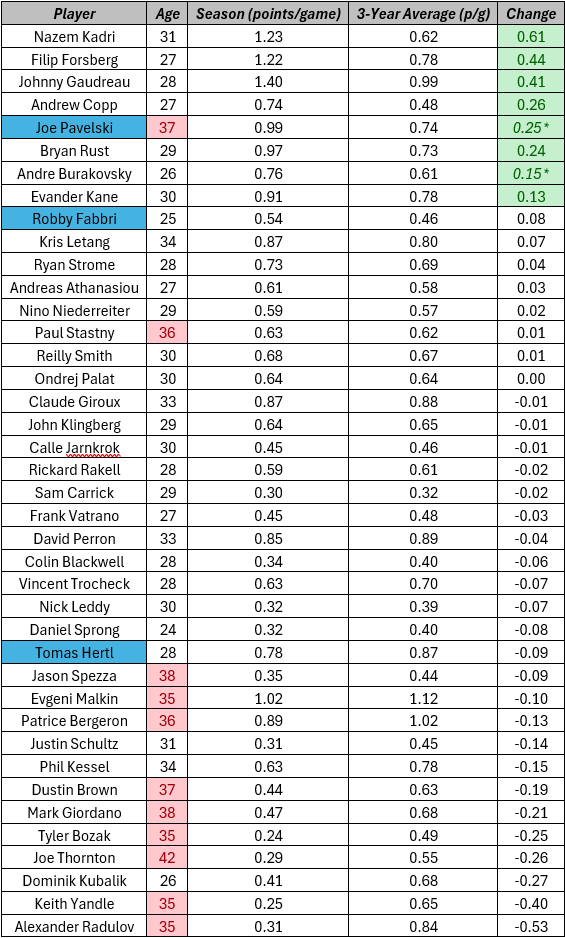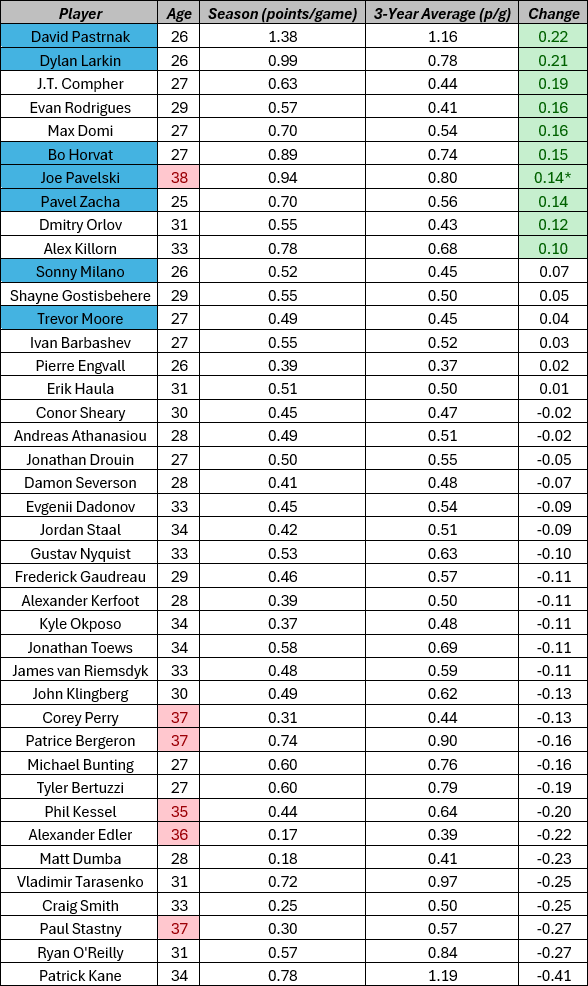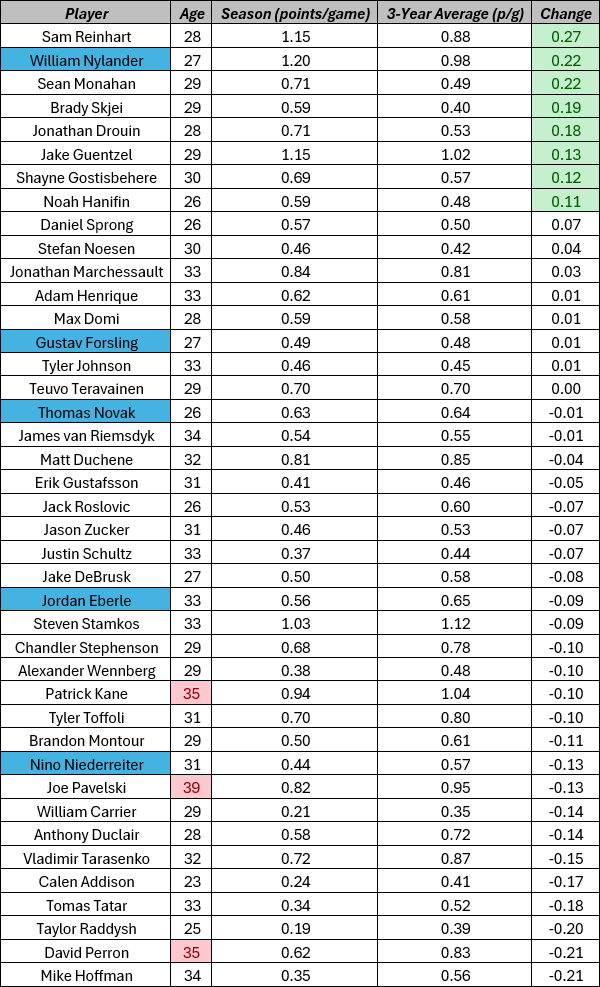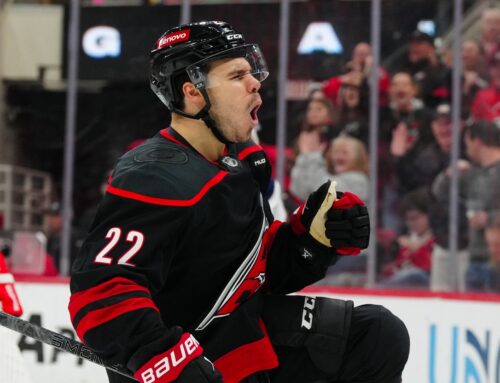When sharing five tips for your fantasy draft, I made the obvious claim that not every player elevates their game when they're in the final year of a contract. One of our lovely readers, Glenn, aptly pointed out that having real data behind that claim would make it more useful. If pending UFAs elevate their game only 10% of the time, then maybe it's not worth considering contract status in preparation for your fantasy draft. However, if that percentage is significantly higher, maybe the contract effect is worth factoring into your draft strategy. In this week's Ramblings, we'll crunch the numbers to help inform your decisions.
The Sample
For a given year, I used PuckPedia to find players that were set to become unrestricted free agents at the end of that season.
To get a sense of which names were fantasy relevant at that point in time, I chose players who tallied at least 0.45 points per game in the previous season. Players that signed extensions before starting the final year of their contract were excluded from my analyses, as were players who played less than 20 games in their contract year.
You'll notice that since my method requires players to score at roughly half a point per game prior to their contract year, I miss players who come out of nowhere to thrive in the final year of their deal, like Valeri Nichushkin and Mason Marchment in 2021-22. These cases were rare and wouldn't throw off the trends very much, but it's important to note they exist. In addition, I think there are more reliable markers that help us identify these 'breakout' players than just contract status. For instance, when Nichushkin posted a 31-point pace in 2020-21, he was skating 14 minutes a night. When he broke out with a 69-point pace in 2021-22, his average ice time was up at 19 minutes and his linemates were significantly better. As a result, it seems unfair to say his success was largely driven by contract motivations.
The Process
As you'll see in the tables below, I compared a player's output in the final year of their contract, to their average output over the three seasons prior. For our purposes, a player's point-per-game rate in their contract year must be at least 0.10 points per game greater than their three-year average for us to say they 'elevated their game'. For reference, an increase of 0.1 p/g translates to roughly eight more points over the course of an 82-game campaign.
If you judge a fish by its ability to climb a tree, you'll never know it's true intelligence. Einstein's wisdom is applicable here because we're focusing on point production, but a player might elevate their game by scoring more goals in a contract year, or racking up more hits, or blocks or shots. It can be helpful to consider a player's style and role when considering how they might elevate their game in a contract year, but since points are universal, I thought it made the most sense for this preliminary analysis.
False Positives
The process described above is far from perfect. I took the mean (average) of a player's recent output, but the mean is sensitive to outliers. So, one extremely bad year within that three-year sample could sink a player's reference point-per-game rate, making it easier for their contract year rate to surpass the reference rate. I marked these cases with an asterisk in the 'change' column and elaborated further in the writeup for that season.
False Negatives
One amazing year could also boost a player's three-year average, making it harder for them to exceed their reference rate in a contract year. However, in most cases I don't think we need to account for that.
If a player didn't do as well in a contract year as they did in a non-contract year, was the contract-year boost that significant to their success? I think the only reason a false negative would complicate things is if that recent year of success also happened to be a contract year, because then a previous contract-year boost would prevent us from recognizing a current one, but we wouldn't be accounting for either.
To see if this was a concern, I combed through the 21-22 sample for 'false negatives' but found only two examples – Jason Spezza and Joe Thornton. However, both players were well past their prime and on a string of one-year deals – it's just that their three-year average was inflated by a productive season prior to the onset of age-related decline. This didn't really fit the concern I had, so I'm not too worried about false negatives undermining our contract-year effects.
Interpreting the Tables
Red cells in the 'Age' column mark players who were 35 or older for most of that season. For example, if they turned 35 in December, they were aged 35 for most of the season – even though they started the campaign at 34.
Blue cells in the 'Player' column mark players who signed a contract extension during the season.
Green cells in the 'Change' column highlight cases where a player's contract-year output was at least 0.10 points per game more than his average rate over the previous three years. For our purposes, these are players who elevated their game in a contract year. Players with asterisks are false positives (see False Positives section above).
2021-22

In 'The Process' section, we discussed the idea of false positives, where one bad year within our three-year reference sample would sink a player's point-per-game rate, making their contract year output look better in comparison. Well, it seems Andre Burakovsky would be an example of that. He posted a 27-point pace with Washington in 2018-19, but then broke out with a 64-point pace and 68-point pace during his first two years with Colorado. However, that poor year in Washington sinks his average and makes his 63-point contract year pace look better than it was. Joe Pavelski shows up as a false positive in multiple seasons, so we'll discuss him in the 'Overall Thoughts' section at the end.
Aside from those two, we mostly have good examples of contract year elevations here – highlighted by Nazem Kadri, Filip Forsberg, and the late Johnny Gaudreau.
~
In-season Extensions
Joe Pavelski posted 1.05 points per game before signing his extension on March 11th, and 0.85 per game afterwards.
Tomas Hertl saw a similar trend, dropping from 0.81 points per game before his March 16th extension, to 0.70 afterwards.
Robby Fabbri went against the grain, going from 0.50 points per game to 0.57 points per game after his December 13th extension.
~
2022-23

While 21-22 had numerous career-best performances that could reasonably be interpreted as contract-year boosts, the 'elevations' in 22-23 are a little more questionable. Alex Killorn, Dmitry Orlov, and Bo Horvat produced at career-high rates and fit the bill, but some other players who met the 'elevation threshold' had produced at high rates prior to their 22-23 contract year, so it's hard to say whether the motivation to secure a new contract was the driving force behind their strong play. However, aside from Pavelski, I wouldn't really classify any of them as blatant false positives.
In-season Extensions
Bo Horvat posted 1.10 points before, and 0.53 after his February 5th extension. However, it's worth noting that his pre-extension games were with Vancouver, and his post-extension games were with the Islanders, so there was a lot more behind that production change than just his contract signing. He wasn’t the only one whose production fell after the extension though…
Joe Pavelski went from 0.97 points per game to 0.91 after his January 1st extension.
Sonny Milano dropped from 0.55 to 0.46 after his February 4th extension.
Trevor Moore dipped from 0.55 to 0.42 after his signing on December 15th.
Our first nonconformist for this season is David Pastrnak. He extended on March 2nd, putting up 1.36 points per game before, and 1.43 afterwards.
Pavel Zacha saw a similar pattern, going from 0.60 to 0.80 after his January 14th extension. Considering he spent time beside Pastrnak down the stretch, it makes sense that their production follows a similar trajectory.
This reverse trend continues with Dylan Larkin, he posted 0.97 points per game before his March 1st extension and 1.05 afterwards.
2023-24


This past campaign provides great examples of players that were likely fuelled by the contract boost – namely Sam Reinhart, William Nylander, and Brady Skjei. However, there are also a few players, like Noah Hanifin and Jake Guentzel, who recently produced at strong rates in non-contract years, which makes it fair to question if the need for a new deal really fuelled their play.
Jonathan Drouin and Shayne Gostisbehere provide food for thought, as both thrived last year on expiring one-year deals. However, before signing those single season deals in the summer of 2023, they would have been on the last year of their previous contracts during the 2022-23 campaign. In other words, while they had motivation to play well in 23-24 for the purpose of securing a new deal, that same motivation was also there in 22-23. However, if you go back and look at the previous year's table, you'll notice neither player elevated their game. Drouin posted an underwhelming 41-point pace in his final year with the Habs, while Gostisbehere managed a modest 45-point pace between Arizona and Carolina. What changed in 23-24 is that they joined new teams, were given better roles, and saw exposure to more talented players. Drouin and Ghost remind us that a player's situation often overrides contract status when assessing fantasy value.
In-season Extensions
Nylander posted 1.46 points per game before signing his contract on January 8th, and 0.98 afterwards.
Gustav Forsling went from 0.51 points per game to 0.44 after signing his extension on March 7th.
Tommy Novak dropped from 0.67 to 0.55 after extending on March 4th.
Jordan Eberle went from 0.63 points per game to 0.37 after gaining contract security on March 8th.
Finally, Nino Niederreiter went from 0.58 points per game before his December 5th extension to 0.38 points per game after.
That's five out of five players this season who produced less after they signed an extension.
Overall Thoughts
The contract year boost doesn't seem to be relevant for older players, specifically those aged 34 and over. I guess this makes sense logically because at that point in a player's career, they've already made their money and aren't as desperate to earn a new contract. Regardless of how motivated they are, there's only so much one can do once age-related decline intensifies.
Although it seems like Joe Pavelski defied father time a couple of times, it's worth noting that in both cases, the three-year average we're comparing against was weighed down by a dreadful 2019-20 campaign that saw him post just 0.46 points per game. That explains his false positives.
Across our sample, we saw players significantly elevate their game in 26 of 135 cases – or 19% of the time. However, if we limit our focus to players under the age of 30, our success rate improves to 27% (19/70). That figure includes Burakovsky's false positive, but not Pavelski's, as Joe was over 30 in both instances. In any case, the contract-year boost seems to be more prevalent for younger players, so don't go expecting the world from 34-year-old John Tavares this season.
It may be nothing, but I found it interesting that 11 of the 15 players (73%) whose contracts were extended during the season saw their production fall post-extension. Obviously, there are many other factors at play, but it makes sense that performance dips since they're no longer playing for job security. Further investigation would be necessary to see if there's a significant effect there, but if a pending UFA on your fantasy roster is about to sign an extension, perhaps it's worth fielding offers if it's just a one-year league.
Takeaway Message
Now, my methods were quite caveman-esque, but one of our readers asked a question, so I did my best to answer it.
As you've likely heard before, correlation does not equal causation. Motivation to secure a new contract may have fuelled players to elevate their game in some cases, but there are many other important factors to consider, including ice time and linemate quality. In fact, I'd say those factors have a greater bearing on a player's fantasy outlook than their contract status.
Overall, I don't think there's a high enough success rate to let contract years hold significant influence over your draft strategy. However, if all else is equal between two players, I certainly wouldn't blame you for choosing the one who's motivated to play for a new deal. I don't see any harm in coming up with your own list of players (under 30 years old) that have potential to pop in a contract year. Just remember that for every Sam Reinhart, there's a Jake DeBrusk and Chandler Stephenson.
~
Thanks for reading! If you ever have any fantasy hockey questions, follow me on Twitter @BrennanDeSouza and shoot me a message!






 ANA
ANA UTA
UTA MIN
MIN CAR
CAR MTL
MTL NYI
NYI VGK
VGK DET
DET NYR
NYR
